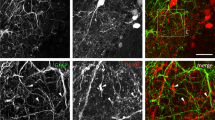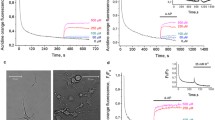Summary
Calcium-dependent release of neurotransmitters is thought to be due to Ca2+ entry into nerve terminals, but the identities of the various voltage-sensitive Ca2+ channels (VSCC) involved in this process remain obscure. To elucidate the types of VSCCs involved in the release process, we studied the effects of various organic Ca2+ channel antagonists and agonists on the release of endogenous γ-aminobutyric acid (GABA) from mouse striatal neurones differentiated in primary culture. Diltiazem, verapamil and methoxyverapamil (D 600) inhibited K+-evoked (30 mM) GABA release at very high concentrations (> 1 μM). The dihydropyridine (DHP) nifedipine, at low concentrations (0.01–1.00 μM), was able to inhibit part of the K+-evoked GABA release (25.6±7.3% inhibition at 1 μM). This is in agreement with the high affinity of nifedipine for DHP binding sites. The DHPs, BAY K 8644 (EC50 = 41±15 nM) and CGP 28.392, which possess agonist properties at VSCCs, increased the 15 mM K+-evoked GABA release. The release evoked by the combination of K+ (15 μM) and BAY K 8644 (up to 10 μM) remained smaller than the release elicited by 30 mM K+. The effect of BAY K 8644 (1 μM) was inhibited by nifedipine (IC50 0.55±0.05 μM). When Na+ ions were replaced by choline, basal and K+-evoked GABA release was significantly increased. Even in the absence of external Na+, nifedipine (1 μM) was not able to totally block the K+ effect. Moreover amiloride, a drug known to inhibit Na+/Ca+ exchange, and tetrodotoxin (TTX), did not modify the 30 mM K+ response. Therefore, nifedipine-insensitive K+-evoked GABA release is not due to Na+-dependent Ca2+ entry. These results can be explained by the presence of DHP-sensitive and insensitive Ca2+ channels on nerve terminals, each involved in the release process.
Similar content being viewed by others
Abbreviations
- CGP 28.392:
-
4-[2-(difluoromethoxy)phenyl]-1,4,5,7-tetrahydro-2-methyl-5-oxo-furo[3,4-b]pyridine-3-carboxylic acid ethylester
- BAY K 8644:
-
(±)-methyl 1,4-dihydro-2,6-dimethyl-3nitro-4-(2 trifluoromethyl) pyridine-5-carboxylate
- DHP:
-
1,4-dihydropyridine
- DIV:
-
days in vitro
- D 600:
-
methoxyverapamil
- GABA:
-
γ-aminobutyric acid
- HEPES:
-
4-(2-hydroxyethyl)-1-piperazineethanesulfonic acid
- HPLC:
-
high performance liquid chromatography
- TTX:
-
tetrodotoxin
- VSCC:
-
voltage-sensitive calcium channel
References
Abe M, Matsuda M (1983) On the existence of two GABA pools associated with newly synthesized GABA and with newly taken up GABA in nerve terminals. Neurochem Res 8:563–573
Aguilera G, Catt KJ (1986) Participation of voltage-dependent calcium channels in the regulation of adrenal glomerulosa function by Angiotensin 11 and potassium. Endocrinology 118:112–118
Albus J, Habermann E, Ferry DR, Glossmann H (1984) Novel 1,4 dihydropyridine (BAY K 8644) facilitates calcium-dependent (3H) noradrenaline release from PC 12 cells. J Neurochem 42:1186–1189
Atlas D, Adler M (1981) Alpha-adrenergic antagonists as possible calcium channel inhibitors. Proc Natl Acad Sci USA 78:1237–1241
Bellemann P, Franckowiak G (1985) Different receptor affinities of the enantiomers of BAY K 8644, a dihydropyridine Ca2+ channel activator. Eur J Pharmacol 118:187–188
Bockaert J, Gabrion J, Sladeczek F, Pin JP, Recasens M, Sebben M, Kemp DE, Dumuis A, Weiss S (1986) Primary culture of striatal neurons: a model of choice for pharmacological and biochemical studies of neurotransmitter receptors. J Physiol (Paris) 81:219–227
Carbone E, Lux HD (1984) A low voltage-activated fully inactivating Ca2+ channel in vertebrate sensory neurones. Nature 310:501–502
Carvalho AP (1985) Calcium transport across isolated synaptic plasma membranes. Abstracts of the 13th International Congress of Biochemistry Amsterdam, The Netherlands, p 21
Carvalho CAM, Santos MS, Carvalho AP (1985) Effects of Ca2+ channel blockers on the (3H)-GABA release and on 45Ca2+ uptake by synaptosomes. Abstracts of the 13th International Congress of Biochemistry Amsterdam, The Netherlands, p 336
Ceccarelli B, Hurlbut WP (1980) Vesicle hypothesis for the release quanta of acetylcholine. Physiol Rev 60:396–441
Cohen J, Gutman Y (1979) Effect of verapamil, dantrolene and lanthanum on catecholamine release from rat adrenal medulla. Br J Pharmacol 65:641
Di Renzo G, Amoroso S, Taglialatela M, Annunziato L (1984) Dual effect of verapamil on K+-evoked release of endogenous dopamine from arcuate nucleus-median eminence complexe. Neurosci Lett 50:269–272
Erdreich A, Spanier R, Rahamimoff H (1983) The inhibition of Na+-dependent Ca2+ uptake by verapamil in synaptic plasma membrane vesicles. Eur J Pharmacol 90:193–202
Ferry DR, Goll A, Glossmann H (1983) Differential labelling of putative skeletal muscle calcium channels by (3H)-nifedipine, (3H)-nitrendipine, (3H)-nimodipine and (3H)-PN-200–110. Naunyn-Schmiedeberg's Arch Pharmacol 323:276–277
Floreani M, Luciani S (1984) Amiloride: relationship between cardiac effects and inhibition of Na+/Ca2+ exchange. Eur J Pharmacol 105:317–322
Franckowiak G, Bechem M, Schramm M, Thomas G (1985) The optical isomers of the 1,4-dihydropyridine BAY K 8644 show opposite effects on Ca channels. Eur J Pharmacol 114:223–226
Freedman SB, Dawson G, Villereal ML, Miller RJ (1984) Identification and characterization of voltage-sensitive calcium channels in neuronal clonal cell lines. J Neurosci 4:1453–1467
Galizzi JP, Borsotto M, Barhanin J, Fosset M, Lazdunski M (1986) Characterization and photoaffinity labeling of receptor sites for the Ca2+ channel inhibitors d-cis-diltiazem, (±)-bepridil, desmethoxyverapamil and (+)-PN-200–110 in skeletal muscle transverse tubules membranes. J Biol Chem 261:1393–1397
Galper J, Catterall W (1978) Inhibition of sodium channels by D 600. Mol Pharmacol 15:174–178
Gola M, Ducreux C (1985) D 600 as a direct blocker of Ca-dependent K currents in Helix neurones. Eur J Pharmacol 117:311–322
Hausdorff WP, Aguilera G, Catt KJ (1986) Selective enhancement of angiotensin II and potassium-stimulated aldosterone secretion by the calcium channel agonist BAY K 8644. Endocrinology 118:869–874
Hess P, Lansman JB, Tsien RW (1984) Different modes of Ca channel gating behaviour favoured by dihydropyridine Ca agonists and antagonists. Nature 311:538–544
Hogan DL, Kraemer KL, Isenberg JI (1982) The use of high performance liquid chromatography for quantitation of plasma amino acids in man. Anal Biochem 130:95–101
Katz B (1969) The release of neural transmitter substances. Liverpool University Press, Liverpool
Kokubun S, Reuter H (1984) Dihydropyridine derivatives prolong the open state of Ca2+ channels in cultured cardiac cells. Proc Natl Acad Sci USA 81:4824–4827
Kongsamut S, Miller RJ (1986) Nerve growth factor modulates the drug sensitivity of neurotransmitter release from PC 12 cells. Proc Natl Acad Sci USA 83:2243–2247
Kuan YF, Scholfield CN (1986) Ca-channel blockers and the electrophysiology of synaptic transmission of the guinea pig olfactory cortex. Eur J Pharmacol 130:273–278
Lee HR, Roeske WR, Yamamura HI (1984) High affinity specific (3H) (+) PN 200–110 binding to dihydropyridine receptors associated with calcium channels in rat cerebral cortex and heart. Life Sci 35:721–732
Lübbecke F, Horvath E, Ferry D, Glossmann H (1982) Pharmacological properties of alpha1-adrenoceptors determined by 125I-HEAT binding. In: Dumont JE, Nunez J, Schultz G (eds) Hormones and cell regulation, vol 6. Elsevier Biomedical Press, pp 179‐186
McGee R, Schneider JE (1979) Inhibition of high affinity synaptosomal uptake systems by verapamil. Mol Pharmacol 16:677
Matsumura Y, Sasaki Y, Shinyama H, Morimoto S (1985) The calcium channel agonist BAY K 8644 inhibits renin release from rat kidney cortical slices. Eur J Pharmacol 117:369–372
Middlemiss DN (1986) The calcium channel activator BAY K 8644 enhances K+-evoked efflux of acetylcholine and noradrenaline from rat brain slices. Naunyn-Schmiedeberg's Arch Pharmacol 331:114–116
Middlemiss DN, Spedding MS (1985) A functional correlate for the dihydropyridine binding site in rat brain. Nature 314:94–96
Miller RJ (1985) How many types of calcium channels exist in neurones? Trends Neurosci 8:45–47
Miller RJ, Freeman SB (1984) Are dihydropyridine binding sites voltage-sensitive calcium channels? Life Sci 34:1205–1221
Motulsky HJ, Snavely MD, Hughes RJ, Insel PA (1983) Interaction of verapamil and other calcium channel blockers with alpha1 and alpha2 adrenergic receptors. Circ Res 52:226–231
Murphy KMM, Gould RJ, Largent BL, Snyder SH (1983) A unitary mechanism of calcium antagonist drug action. Proc Natl Acad Sci USA 80:860–864
Nilius B, Hess P, Lansman JB, Tsien RW (1985) A novel type of cardiac calcium channel in ventricular cells. Nature 316:443–445
Norris PJ, Dhaliwal DK, Druce DP, Bradford HF (1983) The suppression of stimulus evoked release of amino acid neurotransmitters from synaptosomes by verapamil. J Neurochem 40:514–521
Nowycky MC, Fox AP, Tsien RW (1985a) Long-opening mode of gating of neuronal calcium channels and its promotion by the dihydropyridine calcium agonist BAY K 8644. Proc Nail Acad Sci USA 82:2178–2182
Nowycky MC, Fox AP, Tsien RW (1985b) Three types of neuronal calcium channel with different calcium agonist sensitivity. Nature 316:440–443
Ogura A, Takahashi M (1984) Differential effect of a dihydropyridine derivative to Ca 21 entry pathways in neuronal preparations. Brain Res 301:323–330
Pearce BR, Dutton GR (1981) K+ stimulated release of endogenous glutamate, GABA, and other amino acids from neuron- and glia-enriched cultures of rat cerebellum. FEBS Letts 135:215–218
Perney TM, Hirning LD, Leeman SE, Miller RJ (1986) Multiple calcium channels mediate neurotransmitter release from peripheral neurons. Proc Natl Acad Sci USA 83:6656–6659
Pin JP, Weiss S, Sebben M, Kemp DE, Bockaert J (1986) Release of endogenous amino acids from striatal neurons in primary culture. J Neurochem 47:594–603
Ramkumar V, El-Fakahany EE (1986) The current status of the dihydropyridine calcium channel antagonist binding sites in the brain. Trends Pharmacol Sci 7:171–172
Reynolds IJ, Wagner JA, Snyder SH, Thayer SA, Olivera BM, Miller RJ (1986) Brain voltage sensitive calcium channel subtypes differentiated by omega-conotoxin fraction GVIA. Proc Natl Acad Sci USA 83:8804–8807
Schellenberg GD, Anderson L, Swanson PD (1983) Inhibition of Na+/Ca2+ exchange in rat brain by amiloride. Mol Pharmacol 24:251–258
Schoemaker H, Langer SZ (1985) (3H) Diltiazem binding to calcium channel antagonists recognition sites in rat cerebral cortex. Eur J Pharmacol 111:273–277
Schramm M, Thomas G, Towart R, Franckowiak G (1983) Novel dihydropyridines with positive inotropic action through activation of Ca2+ channels. Nature 303:535–537
Siegl PKS, Cragoe EJ, Trumble MJ, Kaczorowski GJ (1984) Inhibition of Na+/Ca2+ exchange in membrane vesicle and papillary muscle preparations from guinea pig heart by analogs of amiloride. Proc Natl Acad Sci USA 81:3238–3242
Spedding M, Middlemiss DN (1985) Central effects of Ca2+ antagonists. Trends Pharmacol Sci 6:309–310
Starke K, Späth L, Wichmann T (1984) Effects of verapamil, diltiazem and ryosidine on the release of dopamine and acetylcholine in rabbit caudate nucleus slices. Naunyn-Schmiedeberg's Arch Pharmacol 325:124–130
Szerb JC (1983) Mechanisms of GABA release. In: Hertz L, Kvamme E, McGeer EG, Schousboe (eds) Glutamine, glutamate and GABA in the central nervous system. New York, pp 457–472
Takahashi M, Ogura A (1983) Dihydropyridines as potent calcium channel blockers in neuronal cells. FEBS Letts 152:191–194
Takahashi M, Tsukui H, Hatanaka H (1985) Neuronal differentiation of Ca2+ channel by nerve growth factor. Brain Res 341:381–384
Thayer SA, Murphy SN, Miller RJ (1986) Widespread distribution of dihydropyridine-sensitive calcium channels in the central nervous system. Mol Pharmacol 30:505–509
Toll L (1982) Calcium antagonists, high affinity binding and inhibition of calcium transport in a clonal cell line. J Biol Chem 257:13184–13192
Turner TJ, Goldin SM (1985) Calcium channels in rat brain synaptosomes: identification and pharmacological characterization. J Neurosci 5:841–849
Weiss S, Pin JP, Sebben M, Kemp DE, Sladeczek F, Gabrion J, Bockaert J (1986) Synaptogenesis of cultured striatal neurons in serum free medium: a morphological and biochemical study. Proc Natl Acad Sci USA 83:2238–2242
Zernig G, Moshammer T, Glossmann H (1986) Stereospecific regulation of (3H) inositol monophosphate accumulation by calcium channel drugs from all three main chemical classes. Eur J Pharmacol 128:221–229
Author information
Authors and Affiliations
Additional information
Send offprint requests to J.-P. Pin at the above address
Rights and permissions
About this article
Cite this article
Pin, JP., Bockaert, J. Multiple voltage-sensitive calcium channels are probably involved in endogenous GABA release from striatal neurones differentiated in primary culture. Naunyn-Schmiedeberg's Arch Pharmacol 336, 190–196 (1987). https://doi.org/10.1007/BF00165804
Received:
Accepted:
Issue Date:
DOI: https://doi.org/10.1007/BF00165804




